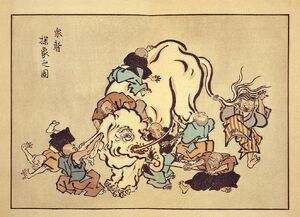
Five Blind Men and an Elephant (with Profit Eristotle joyfully touching the tail).
"Five Blind Men and an Elephant" is perhaps the most individually reprinted SubGenius-masquerading-as-Discordian piece of the 21st century CE. The story features Eristotle, one of the 10 Prophets of Dobbs who is also recognized by Discordians. The "Discordian" version of a Hindu or Jainist story is by Reverend Loveshade and appears in several collections. These include the Non-Existent Apocrypha Discordia, Apocrypha Discordia, Book of Eris, Ek-sen-trik-kuh Discordia (which features a blurb by Rev. Ivan Stang and Rev. Pee Kitty), Principia Harmonia, The Search for Truth: Life Changing Answers to Mankind's Toughest Questions and others. It was the subject of a commentary by U.S. Senate candidate Al Barger and was reviewed by Malaclypse the Younger and Robert Anton Wilson. While the story was supposedly written in the late 20th century, it wasn't officially published until 2001.
Below is the very slightly altered and corrected SubGenius version.
Five Blind Men and an Elephant[]
BloodStar presents:
who ripped it off from the Hindus/Jainists
(We realize that, in the era of the very late 20th century as this is being written, the title and content of this story are politically incorrect. We apologize for any discomfort, but ask you to remember that the original story was created long before political correctness, and is not intended in any way to be offensive to elephants.)
One day five blind men, who knew nothing of elephants, went to examine one to find out what it was. Reaching out randomly, each touched it in a different spot. One man touched the side, one an ear, one a leg, one a tusk, and one the trunk. Each satisfied that he now knew the true nature of the beast, they all sat down to discuss it.
‘We now know that the elephant is like a wall,’ said the one who touched the side. ‘The evidence is conclusive.’
‘I believe you are mistaken, sir,’ said the one who touched an ear. ‘The elephant is more like a large fan.’
‘You are both wrong,’ said the leg man. ‘The creature is obviously like a tree.’
‘A tree?’ questioned the tusk toucher. ‘How can you mistake a spear for a tree?’
‘What?’ said the trunk feeler. ‘A spear is long and round, but anyone knows it doesn’t move. Couldn’t you feel the muscles? It’s definitely a type of snake! A blind man could see that!’ said the fifth blind man.
The argument grew more heated, and finally escalated into a battle, for each of the five had followers. This became known as the Battle of the Five Armies (not to be mistaken for the one described by that Tolkien fellow).
However, before they could totally destroy themselves, a blind SubGenius oracle came along to see what all the fuss was about. While they were beating the crap out of each other, she examined the elephant.
But instead of stopping after one feel, Eristotle touched the whole thing, including the tail, which felt like a rope. ’It’s just a big animal with big sides, ears, feet, tusk teeth, nose and a skinny tail,’ she thought. ‘What a bunch of fools these guys are.’
Then Eristotle said, ‘Stop! I have discovered the truth. I know who is right.’
She being an oracle and all, they stopped and listened and said, ‘Tell us!’
‘I have examined the elephant with mine own two hands,’ she said, ‘and I find that you are all right.’
‘How can this be?’ they asked. ‘Can an elephant be a wall and a fan and a tree and a spear and a snake?’ And they were sorely confused. Eristotle explained, ‘The elephant is a great Tree, and on this tree grow leaves like great Fans to give most wondrous shade and fan the breeze. And the branches of this tree are like Spears to protect it. For this is the Tree of Creation and of Eternal Life, and the Great Serpent hangs still upon it.
‘Unfortunately, it is hidden behind a great Wall, which is why it was not discovered until this very day. It cannot be reached by normal means. ‘However I, in my wisdom, have discovered a Most Holy Rope, by which the wall may be climbed. And if one touches the tree in the proper manner which I alone know, you will gain Eternal Life.’
They all became highly interested in this, of course.
Eristotle named an extremely high price for her services (Eternal Life doesn’t come cheap), and made quite a bundle.
Moral: Anyone can lead blind men to an elephant, but a SubGenius can charge admission.
SubGenius[]
While the story iin its original form is called a Discordian piece, some claim the ending is much more characteristic of SubGenii. "Also the premise of the OP is completely false: a Discordian would generally not give two shits about charging admission -- we'd leave that to the Subgenii." --Vexation
"Excellente! I thought of that when I wrote it, but have never seen anyone point it out before." --Reverend Loveshade (2008)
(Reverend Loveshade, who gave permission for the slightly altered SubGenius version of the story above, said his statement was in error. He said he had heard of the Church of the SubGenius when he wrote the story, but knew nothing about it. It wasn't until maybe a few years later that he realized the prophet might have been SubGenius.)
In early versions, the prophet Eristotle is not named. The name was "discovered" by former Home for Slackless Children counselor Sister Hooter and her assistant Pope Hildegard.